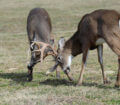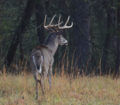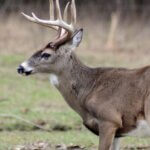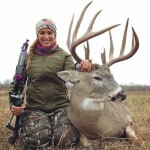Editor’s Note: Three elements cause deer to move – fear, sex and food. Once the hunter understands these three elements, he can predict deer movement more effectively and determine where and when a deer will show up. Fear usually plays a role in deer movement when hunter pressure is intense. Sex influences deer movement during the rut. However, every morning when a deer wakes up, he must decide what he’s eating for breakfast. Deer usually will eat something almost every day. Therefore, a food supply, as it relates to deer, may be the most-dependable ingredient for harvest success.
 Regardless of where I’m hunting, if I’m permitted to hunt a doe as well as a buck, then I’ll always shoot a doe first. Dr. Grant Woods, a well-known deer biologist from Reeds Spring, Missouri, explains why. “One of the keys to know where deer are on the day or the week you’re hunting them is to understand what foods the deer are feeding on for the day of your hunt. The quickest way to make that determination is to shoot a doe for your freezer, take her to your skinning shed, cut her open and look at what’s at the top of her stomach to learn what she’s been feeding on immediately before you shot her. You probably can surmise what food source the bucks in that area are eating too. Then all you have to do is locate the food source the doe has eaten just before you’ve harvested her.”
Regardless of where I’m hunting, if I’m permitted to hunt a doe as well as a buck, then I’ll always shoot a doe first. Dr. Grant Woods, a well-known deer biologist from Reeds Spring, Missouri, explains why. “One of the keys to know where deer are on the day or the week you’re hunting them is to understand what foods the deer are feeding on for the day of your hunt. The quickest way to make that determination is to shoot a doe for your freezer, take her to your skinning shed, cut her open and look at what’s at the top of her stomach to learn what she’s been feeding on immediately before you shot her. You probably can surmise what food source the bucks in that area are eating too. Then all you have to do is locate the food source the doe has eaten just before you’ve harvested her.”
One of the biggest mysteries I had to solve some years ago was the problem of purple deer poop. I was hunting a hardwood bottom near a river and next to a young clear cut. All along the trail that ran through the bottom out into the clear cut was purple deer poop. In the middle of the day, I returned to my stand in the woods and followed that purple poop trail out into the clear cut. There I found my answer. I realized the deer had been feeding on pokeweed, a poisonous plant that can grow to 10 feet tall and has magenta-colored berries and stalks. Southerners use the leaves of the pokeweed plant to prepare poke sallett, cooking it and reboiling fresh water three times to cleanse the dish of impurities. You can find pokeweed all across the U.S.
 The deer not only eat the berries, but on that day, I saw signs of them eating the young leaves as they sprouted on the stems of the pokeweed plants. I also was able to tell from the purple poop where and on what the deer were feeding. After talking with Dr. Grant Woods, I decided that checking a doe’s stomach before starting to hunt a buck would give you a much-more-reliable way to determine what the deer are eating rather than looking for purple poop during hunting season for instance.
The deer not only eat the berries, but on that day, I saw signs of them eating the young leaves as they sprouted on the stems of the pokeweed plants. I also was able to tell from the purple poop where and on what the deer were feeding. After talking with Dr. Grant Woods, I decided that checking a doe’s stomach before starting to hunt a buck would give you a much-more-reliable way to determine what the deer are eating rather than looking for purple poop during hunting season for instance.
Another biologist who’s spent a great deal of time studying deer is Dr. Keith Causey, a retired professor of wildlife biology at Auburn University. He says that, “Deer are so widespread across the United States that they have learned to adapt to a broad range of habitat, including the prairie grasses of Texas and Kansas, the coniferous forests of the West and New England and the southern forests. We know these animals are very tolerant of whatever conditions the environment makes available to them. Because these animals are so adaptable, they can and will eat virtually all food sources.”
 Some years ago, I learned and understood the effect that the acorn of the white oak tree had on deer in a region. I found a big oak tree deep in the swamps. Underneath the tree the ground looked as though a kindergarten class had had a party there – with the leaves all disturbed. Paths went in several directions, and the spot was recognizable from 50 or more yards away because of the way the leaves were disturbed. Deer droppings and a bed of half acorn shells lay on the ground. Even a hunter with very little woods experience would have been able to determine that this was a deer hot spot.
Some years ago, I learned and understood the effect that the acorn of the white oak tree had on deer in a region. I found a big oak tree deep in the swamps. Underneath the tree the ground looked as though a kindergarten class had had a party there – with the leaves all disturbed. Paths went in several directions, and the spot was recognizable from 50 or more yards away because of the way the leaves were disturbed. Deer droppings and a bed of half acorn shells lay on the ground. Even a hunter with very little woods experience would have been able to determine that this was a deer hot spot.
The first afternoon I took a stand 50-yards from the tree, a fat 6 point came in to feed on the acorns and fell to my rifle. I hunted the white oak tree for another two weeks and took two more spikes from under its branches, before the acorns stopped falling from the tree, and the deer quit coming into the area.
When you hunt in a region where deer season with a bow and arrow begins October 15, and November 20 for guns, and runs through the last day of January, you can’t depend on hunting over on one food source all season long. In many sections of the country, one particular food source may not last even a week. Deer seem to change from one preferred food to another within a 10-day to a two week period. Deer don’t like to eat the same food over an extended time and soon tire of one particular food source, eating more than 400 different types of food, including plants, grasses, bark, twigs, berries, young shoots and vegetation. They enjoy variety in their diet because no one food source has all the nutrients they need for their bodies. But when you can find food that the deer are eating regularly, more than likely you have an excellent chance of bagging your buck. Deer eat about 2 pounds of food each day for every 100 pounds of body weight.
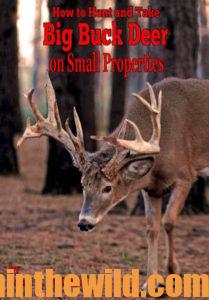
 To learn more about deer hunting, go to John E. Phillips’ books and learn the tactics small property owners have used successfully by checking out John E. Phillips’s book, “How to Hunt and Take Big Buck Deer on Small Properties” at https://www.amazon.com/dp/B00OOC2T0Y#, available in Kindle, print and Audible versions. To receive your free book on “How to Make Venison Jerky,” go to https://www.emailmeform.com/builder/form/Ece3UZVcOo52cKPJcL
To learn more about deer hunting, go to John E. Phillips’ books and learn the tactics small property owners have used successfully by checking out John E. Phillips’s book, “How to Hunt and Take Big Buck Deer on Small Properties” at https://www.amazon.com/dp/B00OOC2T0Y#, available in Kindle, print and Audible versions. To receive your free book on “How to Make Venison Jerky,” go to https://www.emailmeform.com/builder/form/Ece3UZVcOo52cKPJcL

